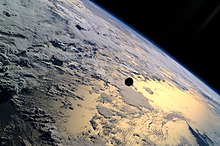PANSAT
| Mission type | Amateur radio satellite |
|---|---|
| Operator | USAF |
| COSPAR ID | 1998-064B |
| SATCAT no. | 25520 |
| Spacecraft properties | |
| Launch mass | 57 kg (126 lb) |
| Dimensions | 50 cm (20 in) |
| Start of mission | |
| Launch date | 30 October 1998, 17:20 UTC |
| Rocket | Space Shuttle Discovery STS-95 |
| Launch site | Kennedy LC-39B |
| Contractor | NASA |
| End of mission | |
| Last contact | 2003 |
| Orbital parameters | |
| Reference system | Geocentric |
| Regime | Low Earth |
| Eccentricity | 0.00072 |
| Perigee altitude | 551 km (342 mi) |
| Apogee altitude | 561 km (349 mi) |
| Inclination | 28.5° |
| Period | 95.8 minutes |
| Epoch | 30 October 1998[1] |
PANSAT (Petite Amateur Navy Satellite, also known as OSCAR 34) was an amateur radio satellite. It was launched by Space Shuttle Discovery during the STS-95 mission as part of the third International Extreme Ultraviolet Hitchhiker (IEH-3) mission, on 30 October 1998 from Kennedy Space Center, Florida.[2][3]

The satellite was built by students from the Naval Postgraduate School in Monterey, California. It offered the possibility of packet radio transmission in BPSK or Direct-Sequence Spread Spectrum in the 70 cm band. The satellite was configured in a sphere-like shape, featuring 26 sides used for solar cell and antenna placement.[4] The spacecraft supplied direct-sequence, spread-spectrum modulation with an operating center frequency of 436.5 MHz, a bit rate of 9600 bit/s and 9 MB of message storage.
References[edit]
- ^ NASA Goddard Space Flight Center. "PANSAT". NSSDCA MAster Catalog. Retrieved 11 February 2020.
- ^ EOPortal.org. "PANSAT". Retrieved 11 February 2020.
- ^ Dirk Krebs, Gunter. "PANSAT (S97-D, PO 34, PANSAT-OSCAR 34)". Gunter's Space Page. Retrieved 13 Feb 2020.
- ^ Martin, Donald H. (2000). Communication Satellites. AIAA. ISBN 978-1-884989-09-4.

